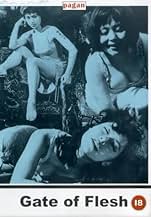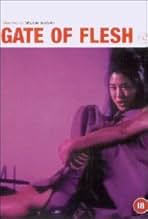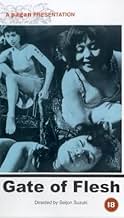IMDb-BEWERTUNG
7,2/10
3590
IHRE BEWERTUNG
Ein verletzter Dieb auf der Flucht findet Zuflucht in einem Bordell mit vereinten, rücksichtslosen Frauen.Ein verletzter Dieb auf der Flucht findet Zuflucht in einem Bordell mit vereinten, rücksichtslosen Frauen.Ein verletzter Dieb auf der Flucht findet Zuflucht in einem Bordell mit vereinten, rücksichtslosen Frauen.
Jô Shishido
- Shintaro Ibuki
- (as Joe Shishido)
Chico Lourant
- Black Pastor
- (as Chico Roland)
Empfohlene Bewertungen
The story revolves around a female prostitution clan (Komasa of Kanto) and their newest arrivals, Maya and Shintaro (Jo "Cheek Implants" Shishido). It takes places in a shantytown located outside of a US military base, immediately after the end of WW2. They survive by selling their bodies and protecting each other, in other words : pimp-less. This is based on a novel by Taijiro Tamura.
We see the story from mostly Maya's perspective. When the story starts out she is a street urchin stealing food to survive. When she is caught by a local pimp and almost peddled to a couple of US servicemen, she inadvertently falls into the hands of the leader of the Komasa (the tattooed, Sen). From there the story revolves about the daily occurrences of street walking, finding food, laying about, singing and various methods of getting money, food and "johns" (lots of petty pickpocketing mostly).
The Komasa of Kanto are identified mostly by the color of their dresses than their names. It is funny to know that the color of the dresses in correspondence with the characters did not have any significant meaning (according to Seijun). The dressed adopted those colors because initially all the dresses and styles looked nearly identical. The colors were used (in typical anime fashion) to differentiate the characters. Mino - purple ; Roku - yellow ; Sen - red ; Maya - green ; Ofuku - white and Machiko - traditional kimono. The group have a few rules, but the most important is not to give up sex for free. We are subjected to the first incident of this with Ofuku. She is tied up, her hair is cut off and she is tied naked to a row boat and left in the harbor for all to see.
After Maya's arrival and adaptation, in comes Jo Shishido. He plays and ex Japanese soldier who goes around committing petty crimes and basically just trying to survive. His introduction is as the sole survivor of a failed raid on the military base supplies. He lives by a simple theory : eat, drink and have as much sex as you can. All the rest are pointless without these basic needs, so forget the higher ideals. He becomes part of Komasa when he stumbles into their "home" after he gets shot because he stabbed a US serviceman (who was involved in the theft at the base and "had it coming"). There is a brief power struggle between him and Sen, but his strength and power make for a natural leader. From then on, everyone defers to him. There also is an attraction for Shishido by both Sen and Maya and the entire groups tries to appease him.
There are elements of the baser and basic survival instincts of man. Those few things that try to elevate above it are crushed and extinguished. Seijun has some personal prejudices when it comes to this movie. He actually served in the Japanese army, stationed in the Phillipines. His military career started and ending with the Japanese retreating. At the time he still felt a bit angry at the US. This is represented in many fashions throughout the movie : the US GI rape of Maya, the MP's not caring, soup/ramen with a condom in it (merchant calls it healthy and nutritious food) and the appearance of the American flag. The flag is used every time something bad happens. It only has negative connotations, especially at the end where it is the last thing we see as the camera pans over the town. There also seems to be some mild capitalist vs communist debate going. At one instant one can hear the song of the international communist brotherhood being sung over all the dealings.
The movie is quite visually stunning. Takeo Kimura (the production designer) designed the sets. He was quite limited with funds. The movie need good sets but they were working with a B-movie budget. He used his theater background to create non-realistic surreal sets (theatre-like). They bring the movie (along with the costumes) to life. It gives the entire movie a theatrical feel. The bridge was even built with stolen used plywood from the props department. To make the paint go a long way, they would dilute the paint with water and add saw dust for thickening. This isn't a documentary. It is not suppose to emulate real life. It is an extreme look at life. Extreme characters in extreme circumstances. The movie also contains numerous scenes of nudity, female on female beatings, numerous sex scenes, plenty of violence and the butchering of a cow (which looks way too life-like). What more can one expect from the grandfather of the exploitation genre ?? I've seen numerous of Seijun's movies prior to this (the most recent being the Beast of Youth), but I was not expecting such a great movie. The Japanese cast and main actors do an excellent job. By the end you really care what happens to them. Seijun also included many American's in the cast as well, so expect to hear some English in the movie. I can't say enough about this movie. What are you still doing reading this, go out and see it for yourself.
-Celluloid Rehab
We see the story from mostly Maya's perspective. When the story starts out she is a street urchin stealing food to survive. When she is caught by a local pimp and almost peddled to a couple of US servicemen, she inadvertently falls into the hands of the leader of the Komasa (the tattooed, Sen). From there the story revolves about the daily occurrences of street walking, finding food, laying about, singing and various methods of getting money, food and "johns" (lots of petty pickpocketing mostly).
The Komasa of Kanto are identified mostly by the color of their dresses than their names. It is funny to know that the color of the dresses in correspondence with the characters did not have any significant meaning (according to Seijun). The dressed adopted those colors because initially all the dresses and styles looked nearly identical. The colors were used (in typical anime fashion) to differentiate the characters. Mino - purple ; Roku - yellow ; Sen - red ; Maya - green ; Ofuku - white and Machiko - traditional kimono. The group have a few rules, but the most important is not to give up sex for free. We are subjected to the first incident of this with Ofuku. She is tied up, her hair is cut off and she is tied naked to a row boat and left in the harbor for all to see.
After Maya's arrival and adaptation, in comes Jo Shishido. He plays and ex Japanese soldier who goes around committing petty crimes and basically just trying to survive. His introduction is as the sole survivor of a failed raid on the military base supplies. He lives by a simple theory : eat, drink and have as much sex as you can. All the rest are pointless without these basic needs, so forget the higher ideals. He becomes part of Komasa when he stumbles into their "home" after he gets shot because he stabbed a US serviceman (who was involved in the theft at the base and "had it coming"). There is a brief power struggle between him and Sen, but his strength and power make for a natural leader. From then on, everyone defers to him. There also is an attraction for Shishido by both Sen and Maya and the entire groups tries to appease him.
There are elements of the baser and basic survival instincts of man. Those few things that try to elevate above it are crushed and extinguished. Seijun has some personal prejudices when it comes to this movie. He actually served in the Japanese army, stationed in the Phillipines. His military career started and ending with the Japanese retreating. At the time he still felt a bit angry at the US. This is represented in many fashions throughout the movie : the US GI rape of Maya, the MP's not caring, soup/ramen with a condom in it (merchant calls it healthy and nutritious food) and the appearance of the American flag. The flag is used every time something bad happens. It only has negative connotations, especially at the end where it is the last thing we see as the camera pans over the town. There also seems to be some mild capitalist vs communist debate going. At one instant one can hear the song of the international communist brotherhood being sung over all the dealings.
The movie is quite visually stunning. Takeo Kimura (the production designer) designed the sets. He was quite limited with funds. The movie need good sets but they were working with a B-movie budget. He used his theater background to create non-realistic surreal sets (theatre-like). They bring the movie (along with the costumes) to life. It gives the entire movie a theatrical feel. The bridge was even built with stolen used plywood from the props department. To make the paint go a long way, they would dilute the paint with water and add saw dust for thickening. This isn't a documentary. It is not suppose to emulate real life. It is an extreme look at life. Extreme characters in extreme circumstances. The movie also contains numerous scenes of nudity, female on female beatings, numerous sex scenes, plenty of violence and the butchering of a cow (which looks way too life-like). What more can one expect from the grandfather of the exploitation genre ?? I've seen numerous of Seijun's movies prior to this (the most recent being the Beast of Youth), but I was not expecting such a great movie. The Japanese cast and main actors do an excellent job. By the end you really care what happens to them. Seijun also included many American's in the cast as well, so expect to hear some English in the movie. I can't say enough about this movie. What are you still doing reading this, go out and see it for yourself.
-Celluloid Rehab
This film proves that good directors are able to make first-rate films in spite of very modest budgets if they have the desire and creativity necessary to succeed. Essentially, this movie concerns the plight of a small number of prostitutes who are trying to survive in post-World War II Tokyo during the American occupation. With food, medicine, shelter and employment in scarce supply those without any resources became like animals just trying to stay alive. So 5 or 6 young prostitutes take refuge in a bombed out basement and agree to live by a very strict code which forbids, among other things, sex without payment. Those who fail to comply are tortured and then thrown back onto the cold streets without any means of protection or support. At any rate, things are going well for this small group until a war-weary Japanese soldier arrives suffering from a gunshot wound. Now, rather than giving away the entire plot I will just say that the director, Seijun Suzuki, uses various techniques (like different colors to differentiate the women) to create something quite impressive out of almost nothing. Just be advised that there is some nudity and violence that wasn't usual for this period in time. But even here he uses symbolism in many cases so that it doesn't seem crass or vulgar. In short, this is a picture that I recommend to those who can appreciate artistry and ingenuity and don't depend on special effects and CGI for their film entertainment. But it's not for the squeamish.
Born on May 24, 1923, Seijun Suzuki was a trade school drop-out and a soldier before studying film at Kamakura academy. After graduating in 1948, he was employed at Ofuna Studio as an assistant director. He began his full-fledged directing career at Nikkatsu in 1954, where he subsequently made 40 films. Most of these were quickie crime thrillers which were akin to Hollywood B-movies. Within the constricting confines of the mercenary studio system, Suzuki was nonetheless able to find his own unique creative sensibility.
His earliest films bear a renegade, sensual flair and a vibrant visual style unsurpassed by more recent work in both the West and Asia. Working in Cinemascope, he used the widescreen frame to full effect, composing intricate shots which seem almost three dimensional, due to somewhat elaborate staging and the novel device of using dissolves to show characters and action on the opposite side of the room or space to which the main camera is pointing.
GATE OF FLESH (1964) exemplifies this. One of Suzuki's most atypical films, it tells the tale of a pimp-less group of hellcat prostitutes trying to survive in the chaotic, crime-ridden arena of post-war Tokyo. Living by a strict code, any of their number can be severely physically punished for sleeping with a man for free. Puffy-cheeked Suzuki regular Jo Shishido plays Shintaro Ibuki, a macho renegade former soldier who deals on the black market and comes to lord it over the band of women. Captivating each of them, he causes a rift among them in which the young novice hooker Maya suffers the most, as she is totally enamored of him. The film is intensely visceral, outrageous, and risque, even today. It must have been positively explosive in 1964, with its sweating, erotically-driven characters, fairly explicit depictions of sex, and savage scenes in which naked women are tied up and whipped by other women. The aggressive sensuality is further enhanced by the Fujicolor processing, which accentuates the reds and greens.
Due to his interpid nonconformism, Suzuki was fired from Nikkatsu in 1968. Amid shake-ups and financial problems at the studio, the suits decided to jettison him for making "incomprehensible" films. This prompted a massive movement on his behalf organized by his fans of time, who were mostly college students. With their support, as well as that of the Director's Guild of Japan, Suzuki filed a court case for wrongful dismissal. He won the case, but the resulting furor got him blacklisted out of the studio system, and Suzuki was only able to resume making feature films in 1977, albeit independently.
His earliest films bear a renegade, sensual flair and a vibrant visual style unsurpassed by more recent work in both the West and Asia. Working in Cinemascope, he used the widescreen frame to full effect, composing intricate shots which seem almost three dimensional, due to somewhat elaborate staging and the novel device of using dissolves to show characters and action on the opposite side of the room or space to which the main camera is pointing.
GATE OF FLESH (1964) exemplifies this. One of Suzuki's most atypical films, it tells the tale of a pimp-less group of hellcat prostitutes trying to survive in the chaotic, crime-ridden arena of post-war Tokyo. Living by a strict code, any of their number can be severely physically punished for sleeping with a man for free. Puffy-cheeked Suzuki regular Jo Shishido plays Shintaro Ibuki, a macho renegade former soldier who deals on the black market and comes to lord it over the band of women. Captivating each of them, he causes a rift among them in which the young novice hooker Maya suffers the most, as she is totally enamored of him. The film is intensely visceral, outrageous, and risque, even today. It must have been positively explosive in 1964, with its sweating, erotically-driven characters, fairly explicit depictions of sex, and savage scenes in which naked women are tied up and whipped by other women. The aggressive sensuality is further enhanced by the Fujicolor processing, which accentuates the reds and greens.
Due to his interpid nonconformism, Suzuki was fired from Nikkatsu in 1968. Amid shake-ups and financial problems at the studio, the suits decided to jettison him for making "incomprehensible" films. This prompted a massive movement on his behalf organized by his fans of time, who were mostly college students. With their support, as well as that of the Director's Guild of Japan, Suzuki filed a court case for wrongful dismissal. He won the case, but the resulting furor got him blacklisted out of the studio system, and Suzuki was only able to resume making feature films in 1977, albeit independently.
Seijun Suzuki's wide screen portrait of post-war Tokyo shows a ruined city reverted back to a primitive state of barbarity, where the only law among the society of pimps, thieves and prostitutes is Survival of the Fittest. Be forewarned: although it may be tame by today's permissive standards the film is still overtly violent, in both content and style. The garish color scheme alone is often more shocking than the animal philosophy of the gang of hookers, whose punishment for compassion among their ranks is an enthusiastic whipping. Suzuki never was the most subtle filmmaker, and the crass, uncensored vitality displayed here approaches low exploitation even while it probes with subtle insight the psychology of a vanquished nation.
Yet another brilliant work from director Suzuki Seijun, who manages to create (in almost every frame) a world in which lurid pulp paperback cover paintings have come to life! This tale of the rampant desperation of mere existence in post-WWII Tokyo is simply stunning on all counts. "Nikutai no Mon" ("Gate of Flesh") is both bleakly realistic, and flamboyantly artistic. It is brutal, shocking, funny, and depressing--sometimes all at once! Excellent cinema--not to be missed by any Japanese film buffs.
Wusstest du schon
- WissenswertesIn an interview Seijun answered the question of the uniqueness of this film in relation to other B/Program pictures he made in the time: "The studio wanted to make a skin flick, that's all. We couldn't make a real porno back then, though."
- PatzerA downward shot pans across a crowd following a stretcher. When straight down, you see the shadow of the camera, crane and the camera operator.
- VerbindungenFeatured in From the Ruins: Making 'Gate of Flesh' (2005)
Top-Auswahl
Melde dich zum Bewerten an und greife auf die Watchlist für personalisierte Empfehlungen zu.
- How long is Gate of Flesh?Powered by Alexa
Details
- Laufzeit
- 1 Std. 30 Min.(90 min)
- Sound-Mix
- Seitenverhältnis
- 2.35 : 1
Zu dieser Seite beitragen
Bearbeitung vorschlagen oder fehlenden Inhalt hinzufügen
























